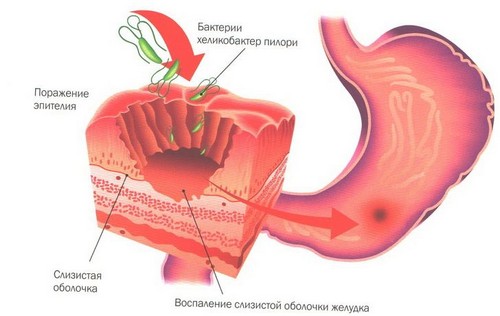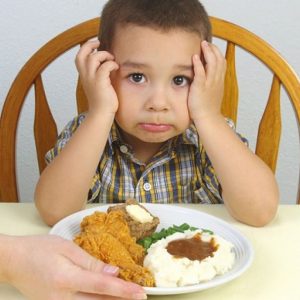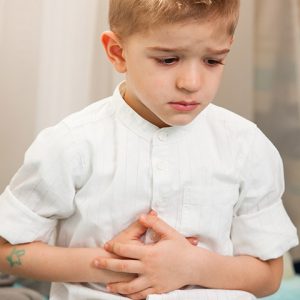According to statistics, chronic diseases of these organs reveal in 10-15% children, often in pure form, they do not meet, there are always signs of associated lesions.
Although gastritis is considered to be a disease of the students and the youth, perhaps their occurrence in children from an early age. Increasingly in the practice of pediatricians are not only younger students but also children of preschool age who suffer from conditions such as gastritis, or its combination with duodenitis.
Is an inflammatory process, often having a chronic, and localized in the walls of the stomach and duodenum.
The cause of the inflammatory process
Among the causes that provoke these pathologies highlights a few key factors, and relationship to the mechanisms of development of gastritis in the past few decades heavily revised. So, in the first place in today’s time, be infection of digestive tract special, acid-fast microbe – Helicobacter pylori (H. pilori), as well as violations of rational nutrition of children, lose other parts of the digestive tract, including parasites, endocrine disorders and nervous signs.
One of the leading causes of lesions of the mucous membranes of the stomach and duodenum with their irritation and inflammation believe poor nutrition of children.

These include:
- irrational introduction of complementary foods and adult table foods
- the unbalanced composition of the food (dense, low vitamins, fatty, spicy)
- poor chewing of food, talking at the table
- receiving too cold or very hot food, excess of spices spicy, salty, sour dishes
- the surplus in food, “food chemistry” and various artificial additives.
Additional factors in the development of gastritis can be considered as taking certain drugs – aspirin, non-steroidal anti-inflammatory drugs, the development of food Allergy, the influence of chemical compounds or radiation exposure.
Can influence pathology and other departments of the digestive system, as well as the General poor state of health. So often gastritis detected on the background of existing pathology of the liver, biliary system or pancreatic lesions, inflammation of the intestine or the body of parasites (worms, Giardia). Can be formed also inflammatory processes in the stomach in the presence of cardiovascular pathologies, diseases of hematopoiesis and anemia, disorders of the kidneys and endocrine pathologies.
Especially dangerous is diabetes mellitus or adrenal insufficiency.
Special effect has a genetic predisposition – if there is a family of people suffering from gastritis, duodenitis or peptic ulcer disease, the risk increases 2-4 times.
The mechanism of development of gastritis
Basic, a leading pathogenic factor is the irritation of the stomach wall is rough, dense, irritating foods, spicy seasonings, fatty foods, drugs with the formation of edema cells, enhance the synthesis of the acid and aggressive factors of the repression of the natural protection of mucous membranes. The secretion of excess gastric juice with a high concentration in the hydrochloric acid affect the stomach wall, especially when rare meals. Constant irritation of the walls of the gastric juice with high acidity and pepsin content, leads to the development of inflammation and gradually the blood circulation in the area of gastric wall (mucosal and podslizistom layer), as well as the nervous regulation of the tone of the stomach and nearby with him 12 duodenal ulcer.
Problems with the blood flow, a state of hypoxia of the tissues of the stomach and guts only reinforce the pathological processes occurring in mucous membranes, formed by suppression of the protective mucus on the cell surface and protective bicarbonate, which neutralizes the excess acid in normal conditions.
Problems with the nervous system lead to the violation of the contractions of the walls of the stomach and intestine, stagnation of food inside of the lumen, whereby the gastric juice longer and increasingly affect the stomach wall. In some cases an additional factor of injury becomes more and backward reflux of bile or secrets of the duodenum into the lumen of the stomach, it’s additionally irritating his mucosa.
Could be one of the instigators allergic reactions – potentially hazardous food leads to the formation on the surface of the mucous membranes of the stomach and guts of their complexes of the allergen with antibodies, which leads to irritation and inflammation of the walls, damage the mucosa and the development of acute gastritis.
When infected with Helicobacter formed the defeat of the walls of the stomach with microbes that are resistant to the aggressive action of hydrochloric acid. Because of this feature of the bacterium is actively growing and developing on mucosal surfaces, leading to erosions and ulcerous defects. Inflammation due to its presence is constantly maintained, thus preventing the defects of the scar, forms the first gastritis, and without treatment, and peptic ulcer disease.

Alteration of the anatomy and functionality of the stomach
It is important that in the development of gastritis are formed by anomalies in the structure of the gastric mucosa appear as focal problems, and diffuse lesions of the epithelium, most clearly traceable during the chronic gastroduodenitis. So, especially damaged active surface of epithelial layer involved in the process of the stomach lining and it and the duodenum. Is formed by the phenomenon of superficial gastritis and duodenitis, which typically hyperemia and edema of the mucosa, the presence of small hemorrhages (bleeding) and erosions (areas without mucosa).
If treatment begins at this stage, everything changes completely eliminate restores the integrity of the mucosa, children with the full treatment to get well.
If the process is not hampered, is the spread of the inflammation to the actual cells of the stomach. They initially increase in size and thicken, which leads to the development of the hypertrophic forms of gastritis with no atrophic processes in the region of the glands producing digestive enzymes and acid. As the process continues, advancing degenerative changes, first by reducing the number of these cells that generates a gradual decline in the production of acid, pepsin and mucus. It leads to violation of the quantitative composition of the gastric juice and digestive problems. Gradually formed a moderate, and then pronounced atrophy (cell death) of the affected mucosa. This clinic subatrophic forms of gastritis, which first goes without atrophy of the glands, and then with her.
After approximately 10 years there may be a decrease in the number of epithelial glands, which transformirovalsya in an inactive or are replaced by elements of connective tissue, gradually the oppression of their functions, strongly expressed, and digestion suffers. Gradually change the structure of the stomach pass into the stage of irreversible anatomical processes, and in fact, the stomach is transformed into a bag, which is practically nothing to digest, and has a significant effect and further digestion and absorption of food in the remaining departments.
The symptoms of gastritis in children
Most often children suffer from chronic gastritis, or concomitant lesions of gastro, and clinical pathology will depend on what age is the disease exacerbation, remission as partial or full completion of the process.
In the period of exacerbation is typical:
- The occurrence of pain in the stomach, which is associated with the fact of eating. When a gastritis, then a typical early pain occurring before meals or during it, or late – after a certain period after a meal. If it’s a total lesion of the stomach or even involving the duodenum, that is frequently observed in children for a long time suffering from digestive disorders, the pain may occur before food intake or at the very beginning, as well as pain after a meal.
- Typical dyspepsia in the form of belching, nausea and episodes of nausea with vomiting.
Acute pain can last to a couple weeks, gradually fading in strength and intensity. At the time of the acute period suffers from the General condition of the child, his appetite and sleep, formed irritability, headaches.
- The doctor notes the pallor of the skin and tenderness at palpation of the abdomen, on examination, the children reflexively straining the stomach in the area of greatest discomfort in podlojecna and around the navel. Also characterized by the increased secretion of the stomach, which makes the children quickly become saturated, and almost immediately after eating there is the urge to have a bowel movement (sometimes even during a meal). It is a pathological “symptom slippage”, it is based on pathological reflexes.
If we talk about kids first years of life, when they have gastritis there are frequent regurgitation, violations of appetite and refusal of food, especially if it is dense as the equivalent of pain attacks.
With incomplete clinical remission:
- In the period of gradually fading inflammation is typically the disappearance of pain, with preservation of pain in the background probing of the abdomen, as well as periods of podtachivaniya.
- Formation of vomiting on the background of the development of reflux and heartburn become less frequent.
In full remission:
- The children look healthy and cheerful, no complaints on the part of health no.
- Changes can be detected through laboratory tests or instrumental examinations.
Variants of the course of pathology
Gastritis in its passage may be latent, with sluggish light symptoms, and recurrent, with a wave of aggravation follow a remission. In addition, in severe cases, it can be continuously recurrent, almost without attenuation. If this latent form of gastritis, it is usually detected accidentally, for example during planned surveys. If we are talking about recurrent course of gastritis, exacerbation may occur one to four times a year, and with continuous current gastritis symptoms almost constant, and is usually that typically for a long period of illness that lasts more than three years. There are also differences in the clinical picture, based on the different localization of inflammatory lesions.
How is the diagnosis: the stages of examination
Suspect symptoms of gastritis you have children of school age on the basis of complaints that they impose. Is pain and their relationship to food and time of day, additional dyspeptic phenomena, changes in skin color, status, language and oral cavity, gums and breath. But diagnosis is not enough, need additional laboratory and instrumental diagnostics. The General blood and urine, protein profile and blood biochemistry, the level of bilirubin and some additional metrics and analysis of feces for digestion, research on H. pylori infection.
To complement the results of the ultrasound will help the digestive system esophagogastroduodenoscopy (EFGDS, or “swallowing light”), and gastric intubation and contrast radiography if necessary. If necessary, the child is placed in a hospital and conduct a number of additional tests, which include pH-meter, study of the activity of the stomach – electrogastrography, additional tests – fecal occult blood test, study of the nervous system and hormones.
Events for the treatment of gastritis in children
In the treatment of gastritis includes the whole range of activities, which are conducted in parallel, and the treatment will be long enough.
In the course of therapy is included as a baseline:
- elimination of H. pylori infection (if detected)
- normalization of level of acidity of gastric secretion
- elimination of pain
As a basic non-pharmacological activities used a special diet that helps digestion and to restore the integrity of mucous membranes in the stomach and in the intestine, which is also often involved in the process, with the addition of enzyme preparations range and prokinetics (they normalize contractility). Can be prescribed antispasmodic drugs aid in removing pain and spasm, and adjusts autonomic disorders, in the period of follow-up care and rehabilitation physiotherapy applicable using course mineral water.
A particular diet for gastritis in children
The treatment of any digestive disorder, including gastritis and duodenitis, especially accompanied by violation of secretion of juices and enzymes for digestion, applies a specific diet. Initially applies table No. 1 with boiled and pureed products, as much as possible sparing the mucous membranes, it is practiced in the period of exacerbation up to two months in a row. With the improvement of the condition of the child may be transferred to a diet of table 2 using sokogonnym dishes, activating the work of digestion, it is also used for a long time, up to two months. It is important on schedule to feed actively and thoroughly chew your food, to comply strictly with all restrictions and requirements for the processing of products.

Diet – the mainstay of treatment, she is offered a leading position in the treatment plan, only sometimes it can be due almost entirely to stop inflammation can then lead a normal lifestyle without the use of pills and injections.
At first, the food all food must be wiped and treated, they are given in the form of mashed, puree, without spices, and any annoying additives, with a minimum of salt or sugar, just warm – hot or very cold items banned. It helps the stomach wall to unload and reduce inflammation.
Necessary eating small portions often so as not to feel hunger, especially for small children. Its nutritive value all food must be complete, which will help to actively restore the health of the stomach wall.
From the diet should exclude:
- Foods and dishes with the contents of roughage and mushrooms
- Fatty and harder to digest meats (lamb, pork)
- Banned all food is fried
- Not fresh pastries, baking, sweets, brown bread
- Banned drinks with coffee and cocoa, strong black or green tea, carbonated drinks (even mineral water).
Also enhanced secretion of the stomach fall under the ban of strong broth, fruit with a sour taste. Actively involved in diet milk and any dairy products, it is necessary to use strong razvratik cereals in water or milk. On the background of decreased gastric secretion, on the contrary, shows the active consumption of soups and nourishing soups, vegetable salads or meals, as applicable drinking acidic juices or milk drinks.
As you improve and decrease in acute manifestations apply the extension of the diet with a constant limit very sour and spicy, irritating or spicy foods. It is important in the diet minimally irritate the mucous membranes.
Medication and complementary therapies
Shown replacement therapy natural gastric juice or pentaglycine during the month, can be shown the drug Abomin, a solution of hydrochloric acid together with pepsin duration to one month and the rate of the enzymes up to 4 weeks.

To improve the nutrition of tissues of the stomach and stimulate the regeneration of the walls is applicable calcium Pantothenate or lipoic acid, Riboflavin and cocarboxylase courses on the recommendation of a physician, and the necessary courses of b vitamins. Complemented by a treatment intake of herbal remedies on the recommendation of a specialist up to one to two months.
To eliminate unpleasant symptoms and improve the General condition on the background of gastritis, especially if the acidity when it is raised, will be applied adsorbents and antacids, the courses will be shown in an average of two to six weeks. Can also be administered drugs antisecretory of a series or a histamine-H2 receptor, and courses can be up to one and a half months, school age may also apply prokinetics and some other tools. Also used drugs, which stimulates the regeneration of the stomach wall (cytoprotector) courses until a month or two. If you are experiencing pain, you can apply antispasmodics in the age dosages.
Additional drug therapy used: a course of mineral water without gas and in the form of heat – Borjomi, Essentuki – 4th or 17th, Slavyanovskaya, up to 150 ml rates up to 40 days, repeat courses up to three times a year.
Physical therapy for gastritis is applied widely and used a variety of methods. For pain syndromes is shown the application of sonication or helium-neon laser in the projection of the epigastrium, therapy of EHF. With the subsiding of the process can be used electric or electrophoresis with b vitamins, novocaine, zinc or platifillina, it is done in the projection of the epigastrium.
After the second week of aggravation may be applied, UHF-therapy, or modulated current, as damping of the process of mud treatments, ozokeritotherapy.
Implementation of follow-up
For the first year from the registration of children on the account with the first episode of gastritis children watching the doctor every quarter, with the improvement of the condition of the child is examined twice a year during periods of possible exacerbations in the fall and spring, and state control ENT doctor and dentist if necessary – other specialists.
Applied survey methods – use of EFGDS once a year, and is the definition of gastric secretion, a series of tests – blood, urine, and fecal tests. According to the testimony may be conducted and additional, prescribed methods. If no exacerbations for three consecutive years, children are considered healthy and removed from the register.




Well-written piece – we need to see more like this, as most info about this topic is generalized. You provide real value to people.
Is it okay if I show your post on FB? It’s very eloquent!
May I expand this? You’ve come up with a well thought out post regardless, so bless you!
It’s a pity you don’t have a donate button! I’d definitely donate to this brilliant blog! I guess for now i’ll settle for bookmarking and adding your RSS feed to my Google account. I look forward to brand new updates and will talk about this website with my Facebook group. Talk soon!
I realy enjoyed this informative post
I realy enjoyed this informative post
I realy enjoyed this informative post